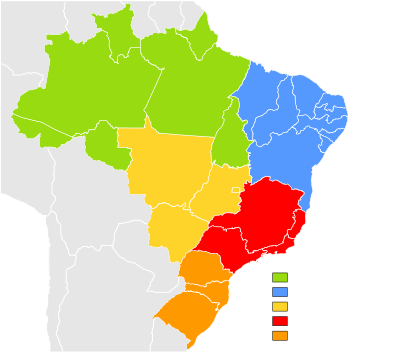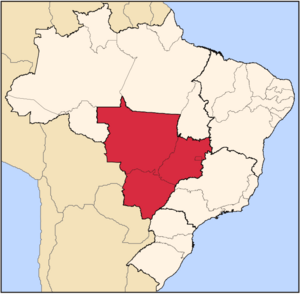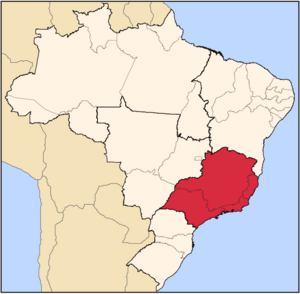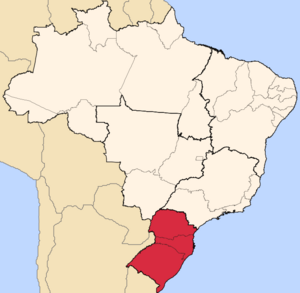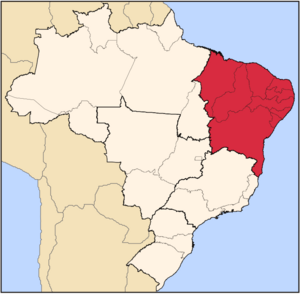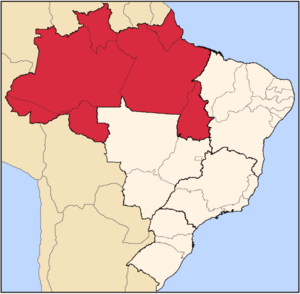Regions of Brazil facts for kids
Brazil is a huge country in South America, so big that it's divided into five main areas, or "macroregions." These regions help us understand the different parts of Brazil better. They are based on things like geography, how many people live there, and what kind of jobs people do. These divisions are mostly for learning and for the government to plan programs. They don't change how states are governed.
Contents
Discovering Brazil's Regions
Brazil's five regions are unique, each with its own special features. Let's explore them!
| Name | Area (km2) | Area (%) | Population (2022 census) |
Population density (per km2) |
Population (%) | Most populous municipality |
Largest metropolitan area | Number of federative units |
|---|---|---|---|---|---|---|---|---|
| Central-West | 1,612,007.2 | 18.86 | 16.2 million | 10.05 | 8.02 | Brasília | Brasília Integrated Development Region | 4 |
| Southeast | 927,286 | 10.85 | 84.8 million | 91.44 | 41.8 | São Paulo | São Paulo metropolitan area | 4 |
| South | 577,214 | 6.75 | 29.9 million | 51.83 | 14.7 | Porto Alegre | Porto Alegre metropolitan area | 3 |
| Northeast | 1,558,196 | 18.29 | 54.6 million | 35.04 | 26.9 | Fortaleza | Recife metropolitan area | 9 |
| North | 3,689,637.9 | 45.27 | 17.3 million | 4.69 | 8.5 | Manaus | Manaus metropolitan area | 7 |
Central-West Region: Brazil's Heartland
This region is in the middle of Brazil. It's known for its wide-open spaces.
- Area: About 1.6 million square kilometers.
- Population: Around 16.2 million people.
- States: Goiás, Mato Grosso, Mato Grosso do Sul, and the Federal District (where the capital, Brasília, is located).
- Largest Cities: Brasília (the national capital), Goiânia, and Campo Grande.
- Climate: Mostly savanna climate, which means it's hot. Winters can be dry in some parts.
- Economy: A lot of livestock (cattle farming) happens here. Farmers grow soybeans, corn, sugarcane, and cotton. There's also mining for nickel, copper, and gold. Tourism is growing, especially in places like the Pantanal.
- Vegetation: Mainly savanna-like plants, called Cerrado. The Pantanal, a huge wetland, is also here. Some parts in the north have equatorial rainforests.
- Special Fact: This region has a low population density. Much of the land is used for grazing animals. It's also known for food and meat processing industries.
Southeast Region: Brazil's Economic Powerhouse
The Southeast is the busiest and most populated part of Brazil. It's the heart of the country's economy.
- Area: About 927,000 square kilometers.
- Population: Around 84.8 million people, making it the most populated region.
- States: Espírito Santo, Minas Gerais, Rio de Janeiro, and São Paulo.
- Largest Cities: São Paulo (Brazil's largest city), Rio de Janeiro, and Belo Horizonte. Many other big cities are here too.
- Climate: Mostly tropical, with warm, wet summers and drier winters. Some areas in the south are more temperate.
- Economy: This region is a major center for manufacturing (cars, electronics, steel, chemicals). It's also important for coffee, sugarcane, and orange juice production. Tourism is huge, especially in cities like Rio de Janeiro. There's also iron and gold mining and oil production.
- Vegetation: Mostly tropical forests, known as the Mata Atlântica. Sadly, very little of the original forest remains.
- Special Fact: The Southeast creates almost half of Brazil's wealth. It has the three most important metropolitan areas in the country.
South Region: European Influences and Cool Climates
The South Region is known for its cooler climate and strong European cultural influences.
- Area: About 577,000 square kilometers.
- Population: Around 29.9 million people.
- States: Paraná, Rio Grande do Sul, and Santa Catarina.
- Largest Cities: Curitiba, Porto Alegre, and Joinville.
- Climate: Subtropical along the coast, with warm summers and mild, humid winters. Inland, it's more temperate, with cold winters and even snow in the highlands.
- Economy: Important for machinery, car, textile, and shoe industries. Soy, corn, wheat, and apples are grown here. The region is also famous for wine production. Tourism is popular, and there's coal mining and energy production.
- Vegetation: Rainforests along the coast and subtropical forests inland. In the south, there are prairies called Pampas.
- Special Fact: This region has a high quality of life. Many European immigrants settled here in the 19th and 20th centuries, bringing their traditions, architecture, and food.
Northeast Region: Brazil's Historic Coastline
The Northeast is where Brazil's history began, with beautiful coastlines and a warm climate.
- Area: About 1.5 million square kilometers.
- Population: Around 54.6 million people.
- States: Alagoas, Bahia, Ceará, Maranhão, Paraíba, Pernambuco, Piauí, Rio Grande do Norte, and Sergipe.
- Largest Cities: Salvador (Brazil's first capital), Fortaleza, and Recife.
- Climate: Hot all year long. Tropical near the coast and semi-arid further inland.
- Economy: Tourism is a big part of the economy, thanks to the stunning beaches. Farmers grow tropical fruits like coconut, papaya, and mango, as well as cocoa and sugarcane. There's also textile manufacturing and wind energy production.
- Vegetation: Tropical forests along the coast. Inland, there's a dry, desert-like vegetation called Caatinga.
- Special Fact: This was the first part of Brazil discovered by the Portuguese. The region has been growing economically, reducing the gap with other parts of the country.
North Region: The Amazon's Heart
The North Region is the largest in Brazil, famous for being home to most of the Amazon Rainforest.
- Area: About 3.6 million square kilometers, almost half of Brazil's total land.
- Population: Around 17.3 million people.
- States: Acre, Amapá, Amazonas, Pará, Rondônia, Roraima, and Tocantins.
- Largest Cities: Manaus and Belém.
- Climate: Equatorial, meaning it's hot and humid all year with lots of rain.
- Economy: Rich in minerals like iron, copper, and gold. Farmers grow açaí and pineapple. There's also energy production and electronics manufacturing. Tourism often focuses on nature and the Amazon River.
- Vegetation: Almost the entire region is covered by the Amazon Rainforest. The state of Tocantins has more savanna-like vegetation. Most of the native forest still remains.
- Special Fact: This region has the lowest population density in Brazil. Cities are far apart, and rivers are the main way to travel. It's a vital area for global biodiversity.
Brazil's Diverse People
Brazil is known for its incredible mix of people from different backgrounds. Over many years, people from Europe, Africa, and the Native Americans who were already living there have all contributed to the country's unique culture and population. This mix makes Brazil a truly diverse and vibrant place! While the exact blend of ancestries can vary slightly from one region to another, the overall picture is one of a rich cultural melting pot that makes Brazil so special.
See also
 In Spanish: Regiones de Brasil para niños
In Spanish: Regiones de Brasil para niños
- Biomes in Brazil
- Brazil socio-geographic division
- Demographics of Brazil


